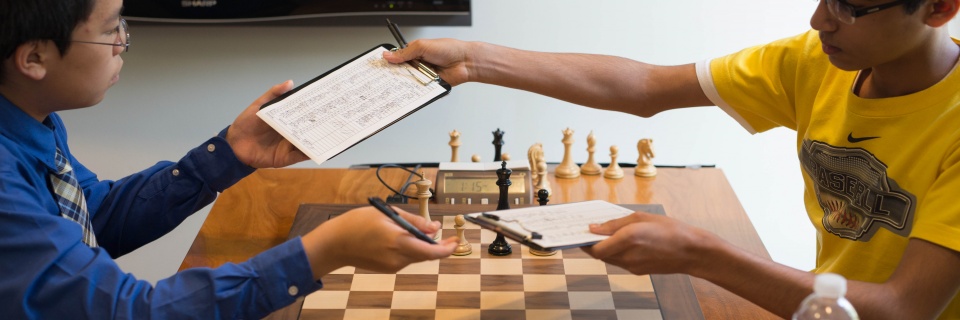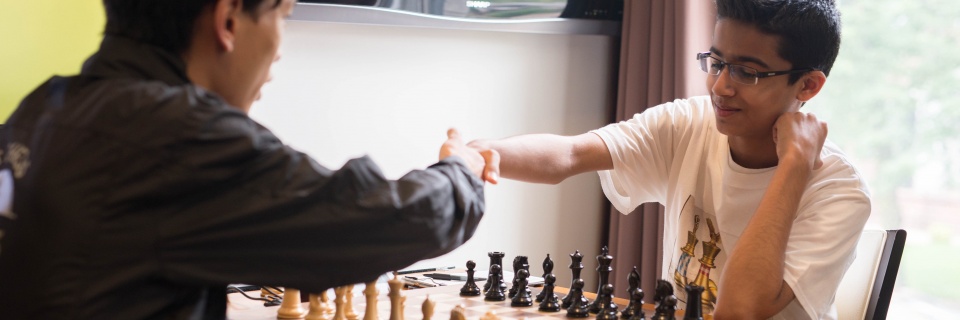2012 U.S. Championships News
Written and analyzed by GM Mackenzie Molner. Photos taken by Austin Fuller.
Arthur Shen vs. Mika Brattain
Arthur Shen is the only player in the tournament to have played all decisive games. The streak continued once again on round six! Going into the game, Mika Brattain, along with Xiong, was playing the most solid chess of the tournament. His Caro-Kann opening move perfectly melded with his solid style of play. Arthur chose the highly ambitious 3. f3, known as the Fantasy variation. In comparison to most other variations of the Caro-Kann, the Fantasy variation leads to more open positions than usual, often resembling the King’s Gambit.
Brattain played the mainline, but Shen added a slight twist to the variation with his move 7. Bd3. It’s more common for White to place the bishop on c4 but some strong players have recommended Arthur’s choice. It keeps the c4 square open for White’s d2 knight and keeps a better guard of the e4 pawn. Brattain handled the opening well and by move 16 had nearly equalized. His move Rc8 was slightly inaccurate and led to a stable advantage for White. 16… Qc7 was a better choice, allowing Black to bring the f8 rook to the defense of the queenside. Brattain could have improved on his 20th move by playing bxa4, equalizing completely. Shen made the most of this inaccuracy and built up pressure on Black’s c4 pawn. White won the pawn on move 27, leaving Black defenseless against White’s powerful central passers.
The 31st move was Black’s last chance to try to set up a defensive fortress by exchanging queens. Black may well be lost in this position anyway, but without the queen exchange, Mika had little hope to control White’s dangerous passers. There were a few tricks that Shen needed to avoid, such as 41. Qxf4?? allowing Qxh3 with a perpetual check. Rather than playing this blunder, Shen’s 41. Qd5+ forced the queens off and connected his center pawns. Black couldn’t offer any more resistance and resigned on move 46. This was the third win in a row for Arthur Shen! He joins Jeffery Xiong in joint second place and only a half point behind the leader, Akshat Chandra. That’s not bad considering 3 rounds ago he was a full 1.5 points behind!
Akshat Chandra vs. Michael Bodek
All eyes were on Chandra going into today’s game. He was leading by a half point over Jeffery Xiong. He was probably feeling quite lucky after narrowly surviving yesterday’s wild game against Li. It appeared that Chandra might be pushing his luck, taking a great deal of time in the opening. It’s possible that he wasn’t familiar with the opening, and as a result took a long time on the moves. This would make his two pawn sacrifice in the opening a curious choice, considering that it is usually most important to have opening knowledge in sharp positions. The game soon reached a repetition even though it looked like Bodek could press. Probably another fortunate result for Chandra.
Luke Harmon-Vellotti vs. Curran Han
Both players came into this game probably feeling a little unsatisfied with their scores thus far in the tournament. Today looked like a good day for Harmon-Vellotti to get back on track with the White pieces against Han. Harmon-Vellotti repeated his round one variation of the Grunfeld against Han. Han played the opening well and maintained balanced chances. Harmon-Vellotti might have been able to improve on his 20th move by playing Nxc3 but even then it would still be hard to crack Black’s position. Instead, after 20. bxa6 the position was unclear, but both players navigated the unusual position well. By move 43, the draw was certain, and agreed upon by both.
Yian Liou vs. Awonder Liang
The tournament started brightly for both of these contestants. Liou started with 2/3 and Liang started with 2.5/3! Despite the strong starts, both players have struggled and lost rounds 4 and 5. They would both be looking to win this game to have any chance at catching the leaders. It seemed that Liang was planning to play his standard opening, the Najdorf Sicilian. Liou would quickly play a sideline though that is currently increasing in popularity. Liou held a constant advantage for the rest of the game. At some points it was probably decisive but never easy to convert. In time pressure, after a very long game, Liou settled for a draw in a complicated but superior endgame.
Ruifeng Li vs. Jeffrey Xiong
Li’s game in round five was one of the most memorable of the tournament. He was White against the tournament leader, Chandra, and was crushing his opponent. A few more accurate moves and he would have won a miniature. Unbelievably, the same story happened today but with different opponents. Li was once again White but this time again the top seed, Jeffery Xiong. Xiong played the French defense, which must have been a surprise because Li thought for 10 minutes on move two. Despite being surprised, Li built up a monumental advantage by move 32. All he needed was one more accurate move. 32. Bh7 would have sealed the deal, but instead played Rh8+. A draw was soon agreed.
Written and analyzed by GM Mackenzie Molner. Photos taken by Austin Fuller.
Ruifeng Li vs. Akshat Chandra
Without a doubt, the game of the day was the match between Ruifeng Li and Akshat Chandra. Chandra went into the game today with a full point lead over the field, with an outstanding score of 3.5/4. Li, was looking to get back into contention with a win today. Li started out with his standard 1. e4 and Chandra responded with a different Sicilian today. Chandra might not have been as familiar with his choice, the Taimanov Sicilian, because at one point out of the opening he was down over an hour on the clock!
Li continued to play moves quickly, keeping the pressure on Chandra. Chandra’s position looked questionable and by move 15 he was already in serious trouble. A potentially disastrous mistake occurred on move 16 for Black, when Chandra chose to accept a pawn sacrifice that blew open his King’s position. This would have proved decisive if Li played the superior move 18. Rhg1. If Li played this, it wouldn’t be surprising to see Akshat resign. Li’s choice of 18. Bh6 was winning but allowed Black to resist. Chandra defended very creatively, marching his King from its castled position over to the queenside. This was definitely a risky thing to do, but by the time the King fulfilled its journey to the c7 square, it was completely safe!
Chandra was even able to begin a strong attack, forcing White to play moves that are usually very undesirable in the Sicilian, like 26. Nb1, and 27. Kd1. It looked like Chandra would somehow escape from a totally lost position all the way to an incredible victory. The position was still complicated though, and with such a major time disadvantage it would have taken some extraordinary play in order to navigate the complications in such a limited amount of time. The complications soon fizzled out to a drawish endgame when Li sacrificed an exchange in order to eliminate Black’s powerful dark-squared bishop. Neither player could do much in order to disturb the balance, and a draw was made shortly after the time control was reached. Without a doubt one of the most exciting games that we have seen this tournament, and a game in which all 3 results were possible! A great display of fighting spirit from the players.
Jeffrey Xiong vs. Yian Liou
Xiong has been off to a solid start, probably more solid than he would like. With the score of 2.5/4 he needed to start winning games in order to catch the leader, Chandra. Despite an extremely slow game with maneuvering struggle, he would eventually get his chance. He found a nice tactic in the endgame based on trapping Liou’s pieces in the middle of the board. This looked like the end of the story, but it was just the beginning. The players fought a strange rook+knight+pawn vs rook+pawn endgame that was nearly impossible to win for Xiong. The players continued in constant time pressure through move 125 before a final mistake from Liou. Xiong capitalized on this and took a win and moving himself within a half point of the lead!
Awonder Liang vs. Luke Harmon-Vellotti
Liang showed his impressive opening flexibility today with his choice of the 4. f3 Nimzo-Indian. The game followed the format of a game that Harmon-Vellotti played against GM Chirila. Liang was the first to deviate. This worked out in his favor, earning an advantage in a very imbalanced position. Liang made the most of his bishop pair, finding a powerful tactic, 27. Nxg7! with a large advantage. Ironically in round four, it was this very same idea that was potentially extremely strong in his game with Black against Arthur Shen. Harmon-Vellotti defended well, and after several mistakes from White, he was pushing for the win. He collected the full point on move 73, winning his first game of the tournament.
Curran Han vs. Arthur Shen
Shen went into round five with the odd distinction of White having a perfect 100% score in all his games. With the Black against Han, surely he wanted this streak to end. The game started out in similar fashion to the Vellotti - Chandra game from round one. That game turned out well for Black, and this opening did as well. The game slowly continued in a positive fashion for Black until Han won a pawn on move 40. The extra pawn gave Han a nice advantage but Shen turned the tables, eventually grinding his opponent down. Shen broke his streak on move 68 when Han resigned.
Mika Brattain vs. Michael Bodek
This game looked to have potential for excitement. Brattain sacrificed a pawn out of the opening for lasting positional pressure. The long-lasting positional pressure, didn’t last long. Bodek found a solid way to give back his extra pawn, reaching a position with symmetrical pawn structure, even material and opposite colored bishops. It looked like a draw was certain, and after exchanging all pieces except the opposite colored bishops, a draw was agreed.
Written and analyzed by GM Mackenzie Molner. Photos taken by Austin Fuller.
Arthur Shen vs. Awonder Liang (Game of the Day)
One of the biggest stories of the tournament so far has been Awonder Liang’s incredible start of 2.5/3 and a share of first place. Many people were wondering if he could maintain this hot streak. His opponent for round four, Arthur Shen, has played some of the most fighting oriented chess of the whole tournament thus far. Arthur has only had decisive games; each one of his games has had White win in a combative Najdorf Sicilian. This created an interesting dynamic between the players because Awonder is mainly a Najdorf player. With Arthur having the White pieces today, and already having success on the White side of the Najdorf, Awonder chose 1… e5 as a more solid opening.
The game started with a quiet Italian game, with both sides maneuvering their pieces in standard fashion. White was able to achieve the move 13. d4 which usually guarantees a more pleasant position. There was still a lot of work to be done, but on move 18 Shen was presented with an interesting opportunity. Liang’s previous move, 17...d5 brought the tension in the center to a boiling point, but they only way for White to take advantage of this move was to make a committal kingside sacrifice. White had two powerful moves in the position: 18. Nxg7 or 18. Bxh6. Shen rose to the occasion and played Bxh6. Although the computer immediately prefers the Nxg7 option, after some thought, it comes around to Arthur’s choice, and recognizes that it is strong as well.
Black’s decisive mistake came on move 23 with the move fxg2. At that point, White had a clear advantage but fxg2 allowed White to earn more material than needed. Arthur converted the advantage quite smoothly, eventually winning a whole piece, forcing Liang’s resignation. A highlight of the technical phase was Arthur’s 33. f4, preparing to push Black off the board, with his extra pawns. The result has big implications in the tournament standings. Shen moves back up to an even score but Liang’s chances of contending for the championship have taken a serious dip. He wasn’t the only person to face some setbacks from round four games. With one exception, the rest of the games from round four were also very exciting! A game worthy of special mention was the Liou-Li game.
Michael Bodek vs. Curran Han
The trend of suffering in the Sicilian continues with this game. Han was able to get a very playable, and at least equal, position out of the opening. Unfortunately a middlegame misstep ruined his chances.16… Nxe4 was a fatal mistake which would cost Han his knight. Han recognized the desperation of the position and, rather than going down a piece, chose to sacrifice his queen for a large material imbalance. This unfortunately was not enough for Black. White went on to prove the worth of the Queen, earning the full point.
Akshat Chandra vs. Mika Brattain

Chandra came into today’s game in shared first place, while Brattain had solidly made 3 draws so far. The opening featured in this game must have came as a surprise to Chandra, although fitting the solid style of play that Brattain had demonstrated so far. Brattain chose to play the 4… a6 Slav. Despite being a popular opening, Chandra went on to think for over 20 minutes in this position. The opening turned out in Black’s favor but needed to be handled in more energetic fashion. 16… Ne4 followed by a kingside pawn storm starting with g5 would have been a seriously challenging idea to White’s position. The game leveled out in the middlegame but Akshat Chandra was able to make the most of his c-file control, gaining a decisive advantage by the time the endgame was reached. The game bordered between drawn and winning in a pawn up rook endgame for Chandra, but eventually he broke his opponent’s defenses, winning the game on move 65. Chandra moves into the lead by a full point with 3.5/4!
Luke Harmon-Vellotti vs. Jeffrey Xiong
This game featured two of the highest rated of the tournament. Luke Harmon-Vellotti, who came into the game with only 1/3, must have been eager to get off to his normal winning ways. However, he wasn’t able to achieve much against Xiong’s Nimzo-Indian defense. The game soon reached a situation in which both sides would have to seriously weaken their position in order to try to win the game. With the upside not being worth the risk, both players repeated moves, agreeing to the draw.
Yian Liou vs. Ruifeng Li
This game was a close second for the game of the day. The game started out with a Najdorf Sicilian that was strongly in White’s favor. White’s queenside play was clearly stronger than Black’s play on the kingside. Li chose to complicate the game with the most spectacular move of the tournament so far, 25… Ne5. Objectively, this move sacrifices a piece for a mere pawn, and was probably not fully sound; however, White was faced with serious practical problems. The problems eventually got the better of Liou. White’s 35th move, Nd2, flipped the evaluation of the position from being better for White, to winning for Black! Li’s strong attack soon proved too much for White, with Black winning on move 39. Liou was in good shape to contend for first place before this game, but the loss is a serious setback.
Written and analyzed by GM Mackenzie Molner. Photos taken by Austin Fuller.
Yian Liou vx. Akshat Chandra (Game of the Day)
Certainly the game of the day! Liou went into the game today in a tie for second place and Chandra in first place. Both players have been playing their top game since the beginning of the tournament. When leaders of a tournament play each other, one of the two players will often play an opening move that is close to vest and not take any chances to upset the tournament situation. The opposite was true today! The players began the game in aggressive fashion with yet another Najdorf Sicilian.
Surely enough, in accordance with games of previous rounds, White chose to combat the Najdorf with another variation featuring the aggressive and thematic move g4. Liou played the opening quickly and in a slightly unorthodox fashion. Liou combined several slow, preparatory moves like 7. Be2 and 9. a3, with an aggressive approach based on a kingside pawn storm. This unorthodox combination of plans allowed Chandra to emerge from the opening with a slight advantage. Despite Black having the preferable chances, White’s position remained solid, and with opposite side castling, all three results were possible.
By move 20 an interesting situation had occurred on the board. On the surface, both players looked posed to start an attack against their opponent’s king but there was no clear sign of either player making progress. Due to the difficulty in starting an attack, both players began a series of maneuvers looking to improve their positions. The maneuvers soon resulted in several exchanges, reaching a watered-down version of an opposite side castling position.The players still continued with the standard pawn storms but due to the reduced material, there was no longer a serious threat of checkmate. The position was balanced, and after further simplifications, Liou and Chandra agreed to a draw on move 32.
Ruifeng Li vs. Luke Harmon-Vellotti
Today, we saw an opening that Luke Harmon-Vellotti specializes in: the French Defense. The French has a very combative reputation, but the variation featured in the game led to a quiet, more positionally oriented struggle. Although Luke’s combination of f6 and h6 in the middlegame didn’t impress the commentators, no serious damage was done. Slowly, Black’s position improved and, eventually, held a classic bishop-pair advantage. Ruifeng defended well and was able to reach a drawn, pawn down, opposite colored bishop endgame. The players quickly agreed to a draw.
Jeffrey Xiong vs. Arthur Shen
Both players came into this game sitting on an even score, although they had both gotten to this score in very different ways. Xiong started the tournament with two very solid draws, while Shen was involved in two wild Najdorf Sicilians full of exciting, attacking chess. The game followed the trend from Shen’s previous games and featured Shen’s third Najdorf Sicilian of the tournament. Shen fared better than his previous effort with Black and, at one point, held a large advantage. As the game approached the second time control, the position was extremely complicated. Xiong was able to make the most of the position’s tactical opportunities, emerging with a winning advantage going into the second time control. Jeffery quickly converted his advantage. The win should give him a big boost, gaining ground on the tournament leaders.
Awonder Liang vs. Michael Bodek
 Bodek trusted in his favorite defense against 1.e4, the Sicilian Dragon. This was a bit of a surprise from Awonder Liang considering that in his first game with the White pieces he began with 1. d4. Awonder proved that he had done his homework and revealed in the postgame interview that he was still in preparation by move 17. His preparation did him wonders (no pun intended), because by the time he was thinking on his own, he already had a significant advantage. Bodek was able to bring the game close to equality on move 25 but Liang’s material advantage eventually proved too much to handle. Awonder is off to a fantastic start with 2.5/3 and a share of the lead!
Bodek trusted in his favorite defense against 1.e4, the Sicilian Dragon. This was a bit of a surprise from Awonder Liang considering that in his first game with the White pieces he began with 1. d4. Awonder proved that he had done his homework and revealed in the postgame interview that he was still in preparation by move 17. His preparation did him wonders (no pun intended), because by the time he was thinking on his own, he already had a significant advantage. Bodek was able to bring the game close to equality on move 25 but Liang’s material advantage eventually proved too much to handle. Awonder is off to a fantastic start with 2.5/3 and a share of the lead!
Curran Han vs. Mika Brattain
Unfortunately for Han, he came into the game today with 0/2. From the start, it appeared his struggles were likely continue. Brattain remained true to his solid play early on in the game, avoiding a complicated, but potentially promising, piece sacrifice on move 12. Brattain could have played the well-known trojan horse bishop sacrifice Bxh2+ leading to complicated play. Han outplayed his opponent in the middlegame, earning an advantage which soon fizzled out. With almost no play left in the position, the players agreed to a draw.
Written and analyzed by GM Mackenzie Molner. Photos taken by Austin Fuller.
Arthur Shen vs. Ruifeng Li (Game of the Day)
With the White pieces today, Arthur Shen was looking to make it back to an even score after a tough loss in the first round. Li, who is usually a Sicilian player, chose to combat 1. e4 with the Najdorf Sicilian. Shen chose a very combative opening variation beginning with 6. h3, preparing a quick kingside pawn storm. Interestingly, it was this very same strategy that proved too tough to deal with for Shen when he played the Black side of the same opening in round one. The game had all the characteristics of a sharp battle right from the beginning with the opposite side castling and pawn storms heading for the kings.
Often in very sharp games such as this, the first inaccurate move can lead to a very difficult position due to the high stake nature of the game. This is exactly what happened on move 14 when Black played Nc4. The slow maneuvering it took to get the knight to this square proved to be too big of a loss of time. This allowed Shen’s strong response 15. Bxc4! which caused a change in the pawn structure and lessening Black’s attacking chances. 14… Nxd4 was needed in order to maintain Black’s fair share of counter chances. Black’s position would remain flexible - with a chance to pawn storm or use the c-file for counterplay. White’s dangerous attacking chances soon transformed into a material advantage which Shen took into a winning, 2 pawn up endgame. Shen converted his advantage in good style. He slowly improved his position while keeping his opponent’s pieces tied down to Black’s weaknesses.
Another hard fought game which has become the norm at the U.S. Junior Closed Championships! Shen’s games from both round one and two show how effective the kingside pawn storm can be in the Sicilian. As a fan of the Sicilian, I hope that we will see Black strike back soon!
Awonder Liang vs. Mika Brattain
 In the past, Awonder Liang has played some daring defenses against 1. d4, such as the King’s Indian. Today Liang started the game in a more solid style: opting for the Ragozin defense. Liang’s 8… Be7 looked uncharacteristic of the Ragozin, and it appeared that White would have decent chances to gain an opening advantage. Brattain was unable to obtain any tangible advantage but maintained a lead on the clock, which would later prove important. The game remained relatively equal until time trouble began to make its’ presence felt. By the time the dust settled from the first time control, Brattain had earned himself a nagging endgame advantage. Despite showing strong technique for a large portion of the endgame, Brattain had to eventually settle for a draw
In the past, Awonder Liang has played some daring defenses against 1. d4, such as the King’s Indian. Today Liang started the game in a more solid style: opting for the Ragozin defense. Liang’s 8… Be7 looked uncharacteristic of the Ragozin, and it appeared that White would have decent chances to gain an opening advantage. Brattain was unable to obtain any tangible advantage but maintained a lead on the clock, which would later prove important. The game remained relatively equal until time trouble began to make its’ presence felt. By the time the dust settled from the first time control, Brattain had earned himself a nagging endgame advantage. Despite showing strong technique for a large portion of the endgame, Brattain had to eventually settle for a draw
Jeffrey Xiong vs. Michael Bodek
Before the game, this was my pick for the most exciting game of the round. Halfway through the round, I realized that the opposite was likely to be true. Unfortunately for the spectators, the opening played in the game had a drawish reputation. Both sides played very accurately throughout the entire game, eventually reaching a symmetrical endgame that was agreed drawn on move 30. A short but high quality game.
Curran Han vs. Akshat Chandra
In round one, Chandra won on the Black side of the Grunfeld defense against one of the highest rated players in the tournament, Luke Harmon-Vellotti. Today, the tables were turned and he was on the opposite side of the same opening. Curran was in a difficult situation, getting Black for the second time in a row, against a player fresh off of a confidence-boosting win. Chandra’s 5. Bd2 was recently featured in the World Championship match between Carlsen and Anand. Chandra continued on with his good form from round one and slowly turned a small positional advantage into the full point.
Yian Liou vs. Luke Harmon-Vellotti
 In round one, Harmon-Vellotti lost with the White pieces against Chandra’s Grunfeld defense. Yian Liou on the other hand, was off to a great start, with a round one victory over Arthur Shen. Harmon-Vellotti tried his luck with 1. e4 today opposed to his first round choice of 1. d4. He faced a former favorite of Magnus Carlsen, and one of Black’s most solid responses to 1.e4, the Breyer variation of the Ruy Lopez. Many of the variations of the Ruy Lopez tend to lead to closed positions, with lots of maneuvering. Vellotti chose not to close the position but this allowed Liou a chance to open up the game favorably for the Black pieces, with 17… exd4! Black generated a strong initiative which soon turned into a decisive advantage. The size of Black’s advantage varied throughout the rest of the game. Luke Harmon-Vellotti was finally able to bail out into a worse, but theoretically drawn endgame. Finally, after more than 120 moves Luke was able to secure the draw. Liou found out why his opponent has a nickname here in St. Louis of Lucky Luke.
In round one, Harmon-Vellotti lost with the White pieces against Chandra’s Grunfeld defense. Yian Liou on the other hand, was off to a great start, with a round one victory over Arthur Shen. Harmon-Vellotti tried his luck with 1. e4 today opposed to his first round choice of 1. d4. He faced a former favorite of Magnus Carlsen, and one of Black’s most solid responses to 1.e4, the Breyer variation of the Ruy Lopez. Many of the variations of the Ruy Lopez tend to lead to closed positions, with lots of maneuvering. Vellotti chose not to close the position but this allowed Liou a chance to open up the game favorably for the Black pieces, with 17… exd4! Black generated a strong initiative which soon turned into a decisive advantage. The size of Black’s advantage varied throughout the rest of the game. Luke Harmon-Vellotti was finally able to bail out into a worse, but theoretically drawn endgame. Finally, after more than 120 moves Luke was able to secure the draw. Liou found out why his opponent has a nickname here in St. Louis of Lucky Luke.
Written and analyzed by GM Mackenzie Molner. Photos taken by Austin Fuller.
Luke Harmon-Vellotti vs. Akshat Chandra (Game of the Day)
Two of the highest rated players, and potential favorites in the tournament, were tasked to face-off right off the bat during the first round matches. The game began in a slightly offbeat line of the Grunfeld Defense that is a pet line of Harmon-Vellotti. I know personally that he has plenty of experience with this line, because he beat me with it last year! Harmon-Vellotti has even played this tactic before in the 2014 U.S. Junior Closed, in the match against Jeffery Xiong.
This particular line from White is often played to avoid a lot of the sharp, complex, and lengthy variations of the Grunfeld, with the option for White to play a simplified endgame. Harmon-Vellotti prefers to keep the game in very combative territory by sacrificing a pawn with his move 6. Bh4. 6. Bf4 would be the more dull alternative, which usually leads to a peaceful endgame. White’s pawn sacrifice leaves him a nice pawn center and more active pieces, but the strength of the extra pawn shouldn’t be underestimated in the long-term.
Black is the first one to err, with the move 11… Bb7. On the surface, this looks like a standard developing move. It protects the rook on a8 while developing, however, the bishop’s placement isn’t improved much on b7. It has no new active possibilities. 11… Nd7 would be a better way to combine Black’s intentions of protecting the a8-rook while also developing. Black on the next turn will play Nb6, placing the knight on a great square, from which it still has chances to improve, with possible jumps into a4 or d5. On b6 it also keeps an eye on the rook on a8. Black will be able to develop the light-squared bishop to a more active square, like e6 or f5, achieving very harmonious development.. White’s best way to try to take advantage of this was the move 12. Qb1. It threatens the immediate Bxc4, which would instantly regain the pawn due to the pin on the b7-bishop, as well as looking to play Qb4, preventing Black from castling.
The game tensely continued until move 19, when it was White who went wrong. White played 19. Rfb1 which seems to improve White’s last piece left out of play. It turns out that it’s still not active enough, allowing the strong response, 19… e4 which is exactly what Chandra plays in the game. Chandra earned a strong initiative which he never let go of. Despite Black castling as late as move 26(!) it was White’s King who faced major troubles. Chandra played a series of strong attacking moves beginning with 27… Bg3, trading off White’s only kingside defender, allowing Black’s pieces to quickly circle the White King. Black’s 31st move fxg4, signaled the end for white, with Black now introducing two new attackers on White’s King, the f8-rook and the g4-pawn, which would play an important role in creating a mating net. With the attacking count to 3 pieces versus no defensive pieces, there was little that White could do.
In a very difficult position, Velotti made his final mistake with 34. Qh6. Although there was no sufficient defensive solution, Qg1 instead would force Black to demonstrate accuracy before winning the game. Chandra brought the last piece into the attack with 35...Rbf7! White resigned due to Black’s unstoppable threats of Qxg1 or Rf5. An impressive and hard-fought struggle from both players led to a great way to kick off the championship!
IM Luke Harmon-Vellotti v. IM Akshat Chandra, Round 1 // Annotation by GM Mackenzie Molner
Yian Liou vs. Arthur Shen
 Perhaps the most surprising game of the round. Liou played the opening in very convincing and aggressive style with a nice novelty 12...c3, improving over games played by players even as strong as Topalov! Black’s response 12…b5 is a completely standard move in the Najdorf but left Black’s position overextended on the queenside. White played the middlegame very precisely. By ruthlessly undermining Black’s queenside pawn structure, he achieved a decisive advantage that he exploited smoothly.
Perhaps the most surprising game of the round. Liou played the opening in very convincing and aggressive style with a nice novelty 12...c3, improving over games played by players even as strong as Topalov! Black’s response 12…b5 is a completely standard move in the Najdorf but left Black’s position overextended on the queenside. White played the middlegame very precisely. By ruthlessly undermining Black’s queenside pawn structure, he achieved a decisive advantage that he exploited smoothly.
Ruifeng Li vs. Michael Bodek
 Li starts out the game with quick and confident moves on the White side of the Dragon, that seem to indicate that he was in his preparation deep into the opening. He could have made the most of this preparation with the move 17. Rb5! This would have held White’s extra pawn, along with a healthy advantage. Instead he played 17. Bd4 which passed the initiative over to Black. Bodek brilliantly seized his chance with a temporary piece sacrifice earning a significant endgame advantage. Bodek held onto a large advantage until 32… f5?. Although Black was still better, Li defended stubbornly and made the draw on move 47.
Li starts out the game with quick and confident moves on the White side of the Dragon, that seem to indicate that he was in his preparation deep into the opening. He could have made the most of this preparation with the move 17. Rb5! This would have held White’s extra pawn, along with a healthy advantage. Instead he played 17. Bd4 which passed the initiative over to Black. Bodek brilliantly seized his chance with a temporary piece sacrifice earning a significant endgame advantage. Bodek held onto a large advantage until 32… f5?. Although Black was still better, Li defended stubbornly and made the draw on move 47.
Jeffrey Xiong vs. Mika Brittain
 Xiong comes into the game as the highest rated player in the tournament and, after winning the Chicago Open, must be the favorite to win the event. After achieving a pleasant opening advantage, Xiong faced stiff resistance in the middlegame and the position quickly went from pleasant for White to dead equal. The game was soon drawn, with the players shaking hands on move 32.
Xiong comes into the game as the highest rated player in the tournament and, after winning the Chicago Open, must be the favorite to win the event. After achieving a pleasant opening advantage, Xiong faced stiff resistance in the middlegame and the position quickly went from pleasant for White to dead equal. The game was soon drawn, with the players shaking hands on move 32.
Awonder Liang vs. Curran (Ray) Han
 Liang came into the game with a sizable rating advantage. The game started out as a Samisch King’s Indian which has an aggressive reputation for White. Despite the aggressive nature of the variation, the queens were traded off by move 11. The position was approximately equal but Liang slowly outplayed his opponent in a positional fashion that shows a level of maturity not normally seen from players of his age. Can put up sturdy resistance but Liang kept up the pressure until he won on move 44.
Liang came into the game with a sizable rating advantage. The game started out as a Samisch King’s Indian which has an aggressive reputation for White. Despite the aggressive nature of the variation, the queens were traded off by move 11. The position was approximately equal but Liang slowly outplayed his opponent in a positional fashion that shows a level of maturity not normally seen from players of his age. Can put up sturdy resistance but Liang kept up the pressure until he won on move 44.






